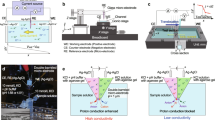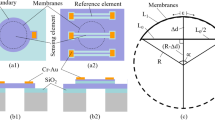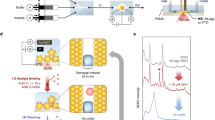Abstract
In this Article we have used new approaches to investigate a well-known chemical process, the propagation of electrochemical signals through a thin glass membrane. This process, which has been extensively studied over the last century, is the basis of the response of a potentiometric glass pH sensor; however, no amperometric glass sensors have yet been reported because of its high ohmic resistance. Voltammetry at nanoelectrodes has revealed that water molecules can diffuse through nanometre-thick layers of dry glass and undergo oxidation/reduction at the buried platinum surface. After soaking for a few hours in an aqueous solution, voltammetric waves of other redox couples, such as Ru(NH3)63+/2+, could also be obtained at the glass-covered platinum nanoelectrodes. This behaviour suggests that the nanometre-thick insulating glass sheath surrounding the platinum core can be largely converted to hydrated gel, and electrochemical processes occur at the platinum/hydrogel interface. Potential applications range from use in nanometre-sized solid-state pH probes and determination of the water content in organic solvents to glass-modified voltammetric sensors and electrocatalysts.
This is a preview of subscription content, access via your institution
Access options
Subscribe to this journal
Receive 12 print issues and online access
$259.00 per year
only $21.58 per issue
Buy this article
- Purchase on Springer Link
- Instant access to full article PDF
Prices may be subject to local taxes which are calculated during checkout






Similar content being viewed by others
References
Murray, R. W. Nanoelectrochemistry: metal nanoparticles, nanoelectrodes and nanopores. Chem. Rev. 108, 2688–2720 (2008).
Fan, F.-R. F. & Bard, A. J. Electrochemical detection of single molecules. Science 267, 871–874 (1995).
Smith, C. P. & White, H. S. Theory of the voltammetric response of electrodes of submicron dimensions. Violation of electroneutrality in the presence of excess supporting electrolyte. Anal. Chem. 65, 3343–3353 (1993).
Sun, P. & Mirkin, M. V. Electrochemistry of individual molecules in zeptoliter volumes. J. Am. Chem. Soc. 130, 8241–8250 (2008).
Bach, H., Baucke, F. K. G. & Krause, D. (eds) Electrochemistry of Glasses and Glass Melts, Including Glass Electrodes (Springer, 2001).
Haugaard, G. The mechanism of the glass electrode. J. Phys. Chem. 45, 148–157 (1941).
Schwabe, K. & Dahms, H. Permeability of the glass electrode to hydrogen ions with the aid of tritium tagging. Monatsber. Deutschen Akad. Wissen. 1, 279–282 (1959).
Vetter, K. J. Electrochemical Kinetics: Theoretical and Experimental Aspects (Academic Press, 1967).
Sun, P. & Mirkin, M. V. Kinetics of electron transfer reactions at nanoelectrodes. Anal. Chem. 78, 6526–6534 (2006).
Attard, G. S. et al. Mesoporous platinum films from lyotropic liquid crystalline phases. Science 278, 838–840 (1997).
Fletcher, S. et al. The response of some nucleation/growth processes to triangular scans of potential. J. Electroanal. Chem. 159, 267–285 (1983).
Shao, Y. & Mirkin, M. V. Fast kinetic measurements with nanometer-sized pipets. Transfer of potassium ion from water into dichloroethane facilitated by dibenzo-18-crown-6. J. Am. Chem. Soc. 119, 8103–8104 (1997).
Masterton, W. L. & Gendrano, M. C. Henry's Law studies of solutions of water in organic solvents. J. Phys. Chem. 70, 2895–2898 (1966).
Harris, D. C. Quantitative Chemical Analysis 6th edn, 397 (W. H. Freeman, 2002).
Hubbard, A. T. & Anson, F. C. The theory and practice of electrochemistry with thin layer cells, in Electroanalytical Chemistry (ed. Bard, A. J.) Vol. 4, 129–214 (Marcel Dekker, 1970).
Vonau, W., Gabel, J. & Jahn, H. Potentiometric all solid-state pH glass sensors. Electrochim. Acta 50, 4981–4987 (2005).
Kreuer, K.-D. Solid potentiometric pH electrode. Sens. Actuat. B 1, 286–292 (1990).
El-Giar, E. E.-D. M. & Wipf, D. O. Microparticle-based iridium oxide ultramicroelectrodes for pH sensing and imaging. J. Electroanal. Chem. 609, 147–154 (2007).
Malkaj, P., Dalas, E., Vitoratos, E. & Sakkopoulos, S. pH electrodes constructed from polyaniline/zeolite and polypyrrole/zeolite conductive blends. J. Appl. Polym. Sci. 101, 1853–1856 (2006).
Bakker, E. & Pretsch, E. Nanoscale potentiometry. Trends Anal. Chem. 27, 612–618 (2008).
Horrocks, B. R. et al. Scanning electrochemical microscopy 19. Ion selective potentiostatic microscopy. Anal. Chem. 65, 1213–1224 (1993).
Shao, Y. et al. Nanometer-sized electrochemical sensors. Anal. Chem. 69, 1627–1634 (1997).
Acknowledgements
The authors gratefully acknowledge support from the National Science Foundation (CHE-0645958) and a grant from PSC-CUNY. The authors would like to thank H. Gafney, F. Laforge and A. Bard for helpful discussions and J. Morales (CCNY electron microscopy facility) for his help with SEM imaging.
Author information
Authors and Affiliations
Contributions
J.V. performed the experiments. D.Z. conceived the experiments and developed analytical tools for nanoelectrode characterization. M.V.M. conceived and designed the experiments, analysed data and wrote the paper.
Corresponding author
Ethics declarations
Competing interests
The authors declare no competing financial interests.
Rights and permissions
About this article
Cite this article
Velmurugan, J., Zhan, D. & Mirkin, M. Electrochemistry through glass. Nature Chem 2, 498–502 (2010). https://doi.org/10.1038/nchem.645
Received:
Accepted:
Published:
Issue Date:
DOI: https://doi.org/10.1038/nchem.645
This article is cited by
-
Inter-facet junction effects on particulate photoelectrodes
Nature Materials (2022)
-
Aqueous ionic effect on electrochemical breakdown of Si-dielectric–electrolyte interface
Scientific Reports (2020)
-
A green non-acid-catalyzed process for direct N=N–C group formation: comprehensive study, modeling, and optimization
Molecular Diversity (2018)
-
Hydrogen-atom-mediated electrochemistry
Nature Communications (2013)
-
Light-controlled synthesis of uniform platinum nanodendrites with markedly enhanced electrocatalytic activity
Nano Research (2013)



